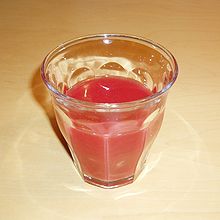This is an old revision of this page, as edited by TravisAF (talk | contribs) at 10:23, 24 April 2009 (unnecessary italics). The present address (URL) is a permanent link to this revision, which may differ significantly from the current revision.
Revision as of 10:23, 24 April 2009 by TravisAF (talk | contribs) (unnecessary italics)(diff) ← Previous revision | Latest revision (diff) | Newer revision → (diff) For other uses, see Orange juice (disambiguation).

Orange juice is a popular beverage. It is a source of vitamin C (ascorbic acid), potassium, folic acid (Vitamin B9). Citrus juices also contain flavonoids that are believed to have beneficial health effects. However, if drunk on an empty stomach, orange juice can exacerbate present gastro-intestinal conditions and/or cause mild and temporary stomach upset. Due to the citric acid, orange juice typically has a pH of 3.5. Drinking or sipping orange juice can therefore cause erosion of the tooth enamel, otherwise known as 'acid erosion'. It is recommended to use a straw so that the juice does not come into contact with the teeth. 200 ml (about 7 ounces) of orange juice accounts for 1 of the recommended 5 pieces of fruit a day by the USDA.
Commercial orange juice and concentrate
Refrigerated juice shipped in liquid form is traded between producers as direct juice. In the USA all commercial orange juice is pasteurized. Some refrigerated fresh juice is sold to consumers. In the U.S., Canada and the U.K. it is labeled "not from concentrate". "Freshly squeezed" juice is unpasteurised and has a shorter life than pasteurised juice, but is considered better quality.
Frozen orange juice concentrate
Freshly squeezed juice and filtered orange juice is pasteurized and is evaporated under vacuum and heat to remove most of the water before it is frozen. This process strips out certain essences and oils. The concentrated juice, about 65° brix, is then stored at about +10°F (-12°C). At this point essences and oils (recovered during the vacuum concentration process) are added back to restore the flavor. To make cans of frozen concentrate for sale, filtered water is added back to bring the brix level down to 42° (about 3 times more concentrated than fresh juice).
When water is added to freshly-unfrozen concentrated orange juice, it is reconstituted. Most of orange juice sold today throughout the world is reconstituted juice. There is a huge difference in the volume of frozen concentrated orange juice and unprocessed juice and this makes a difference in the price the consumer is charged. Orange juice containing pulp seems to be more nutritious than no-pulp varieties because of the flavonoids contained in the pulp.
The major commodity exchanges, including the New York Board of Trade and the Brazilian Mercantile and Futures Exchange, sell futures on frozen orange juice concentrate.
Canned orange juice
A small fraction of fresh orange juice is canned. Canned orange juice does retain Vitamin C much better than bottled juice. However, the canned product loses flavor when stored at room temperature for over 12 weeks.
Major orange juice brands
In the US, the major orange juice brand is Tropicana Products, owned by PepsiCo Inc., which possesses nearly 65% of the market share. Tropicana also has a large presence in Latin America, Europe and Central Asia. Competing products include "Simply Orange," owned by the Minute Maid division of The Coca-Cola Company. Florida's Natural is an orange juice brand based out of Florida that uses only Florida grown oranges.
Additives
Some producers add citric acid or ascorbic acid to juice beyond what is naturally found in the orange. Some also include other nutrients such as calcium and Vitamin D, not found naturally in oranges. Low-acid varieties of orange juice are also available. Omega-3 is sometimes added to orange juice from fish oils.
References
- "Acids". British Soft Drinks Association. Retrieved 2006-09-12.
- "Acid erosion and abrasion:Prevention". aciderosion.co.uk.
- "Is fruit juice as good as whole fruit". World's Healthiest Foods. Retrieved 2007-04-13.
- Yiu H. Hu, József Barta Handbook of Fruits and Fruit Processing. Blackwell Publishing, 2006. p. 327.
- New York Times Article on Orange Juice Additives
External links
- Orange juice production Production process and distinction between juice products.
- Bottled Sunshine... A Juicy Story Brief film clip of orange juice processing from 1968. From the State Library & Archives of Florida.
- Natural orange juice processing Industrial processing of natural orange juice.